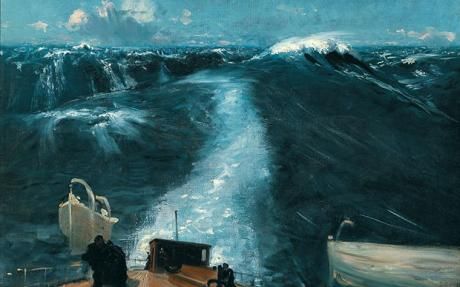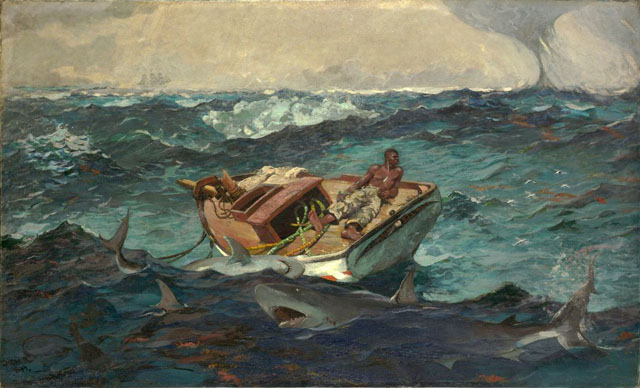Northeaster by Winslow Homer via WikiCommons
My last blogpost got me looking at seascapes and how intensely painters have shown us the muscles and moods of the sea. The examples here show raw water, that ever-heaving force covering most of our planet. The exception is a Winslow Homer, Gulf Stream, too apt to leave out. A man in a broken-masted boat, the sea churning with sharks, a water spout on the horizon. Power and peril.
There’s a subgroup of seascapes depicting the great wooden ships that began stitching the continents together. Outriders of globalization. They started a great intermingling of goods, ores, plants and animals that bent human history like a giant pipe-wrench. One forgets how transformative the sea lanes were before steel hulls and railroad tracks. Paved roads. Cargos in the skies.
A subset of these paintings is seascapes of ships floundering in massive storms. We hear so little about tragedies at sea — have they stopped happening? Or are our hearts and fears focused away from the old fears of watery depths and vital supplies that never arrive?
The Japanese tsunami of 2011 gave us a heart-stopping view of oceanic force. Here are paintings that show how masterfully a painter can conjure the power of oceans with the power of paint.
Max Jensen Großes, Marinestück via WikiCommons
Atlantic Storm by John SInger Sargent via Interface
Gulf Stream by Winslow Homer via The Metropolitan Museum of Art
Seal Rock by Albert Bierstadt via WikiCommons
_____________________________________________________________________
look further;
Impact of early intercontinental shipping
- • The Columbian Exchange: Biological and Cultural Consequences of 1492, by Alfred W. Crosby, Jr.
- “Thirty years ago, Alfred Crosby published a small work that illuminated a simple point, that the most important changes brought on by the voyages of Columbus were not social or political, but biological in nature. The book told the story of how 1492 sparked the movement of organisms, both large and small, in both directions across the Atlantic. This Columbian exchange, between the Old World and the New, changed the history of our planet drastically and forever.
- The book The Columbian Exchange changed the field of history drastically and forever as well. It has become one of the foundational works in the burgeoning field of environmental history, and it remains one of the canonical texts for the study of world history. This 30th anniversary edition of The Columbian Exchange includes a new preface from the author, reflecting on the book and its creation, and a new foreword by J. R. McNeill that demonstrates how Crosby established a brand new perspective for understanding ecological and social events. As the foreword indicates, The Columbian Exchange remains a vital book, a small work that contains within the inspiration for future examinations into what happens when two peoples, separated by time and space, finally meet.” via Amazon
- –
- • on Wikipedia here and here
- Magnificent marine photography in my earlier blogpost, Catching a Wave — With a Camera, May 20, 2012





